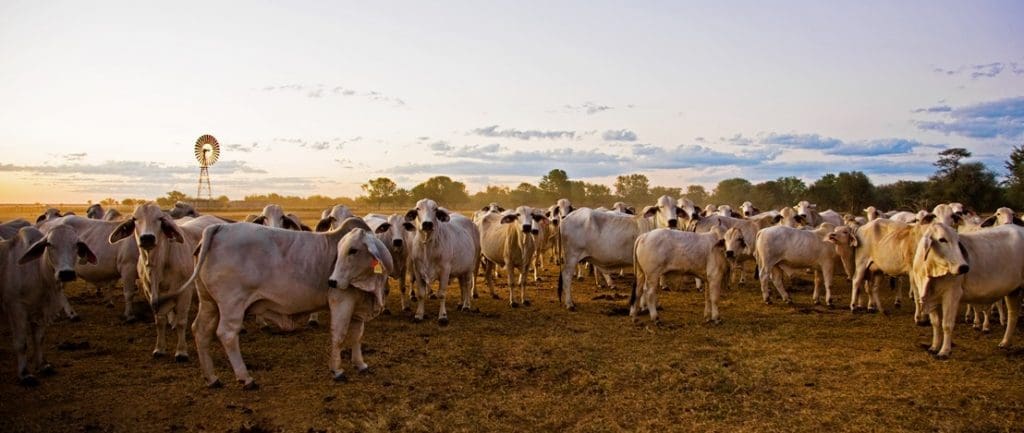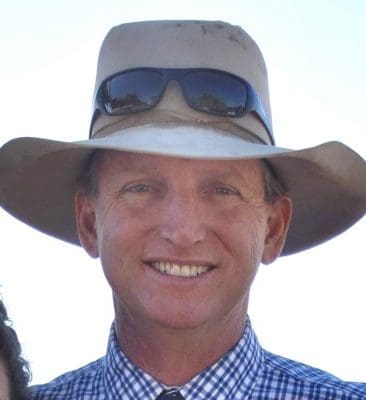
IN OUR final weekly property review for 2019, property industry identities share their thoughts on the year that has been, and what to expect over the coming 12 months.
Danny Thomas, CBRE
At the start of the year, Danny Thomas, the regional director of CBRE agribusiness, held a very pessimistic view about the broader rural transaction space, and up until the federal election in July he admitted it was still difficult.
 “In regard to foreign investment in agriculture, there was uncertainty about both government policies generally, and particularly water policy. Post-election, there was a quick reduction in interest rates, the exchange rate fell slightly and some certainty was injected back into those government policies.”
“In regard to foreign investment in agriculture, there was uncertainty about both government policies generally, and particularly water policy. Post-election, there was a quick reduction in interest rates, the exchange rate fell slightly and some certainty was injected back into those government policies.”
Mr Thomas said those three factors combined to create an environment of greater confidence where the investors returned stronger than ever.
“Last year, CBRE sold between $1.8b and $1.9b worth of agricultural property. This year, we will have sold only slightly less – despite next to nothing being traded in the first quarter,” he said. “So, there has been little difference in the total volume of assets that have transacted over the last two years from our perspective.”
Demand
Mr Thomas said anything that was not in drought was in very high demand.
“There’s strong enquiry for high rainfall properties, particularly those in south-west Victoria and south-east South Australia. Almost every new sale in these areas creates a new land value record. Given the outlook for livestock values going forward, we may well see these markets continue to strengthen.”
In terms of international money in the current market, Mr Thomas explained it was overwhelmingly North American.
“There is an absence of mainland Chinese funds in this market. There is some new Asian inquiry out of Japan, Korea and Taiwan, but there’s been little to no action.”
Prospects for 2020
Questions are being asked about how producers will continue to pay their bills if they have no livestock and it remains dry.
Mr Thomas said he was not seeing significant movement from lenders, suppliers or anyone else in terms of credit tightening.
“Finance providers appear to remain supportive of good farming businesses. So, provided producers can still get access to credit to meet their cash flow requirements, and if they have managed their businesses well and are controlling their costs, then I am not sure what the call-to-action will be for these people to sell,” he said.
Financial, family, and health issues were typically the factors that generated forced sales.
Mr Thomas said if there was a rush of forced property sales next year, there may be some good value buying opportunities, but these would likely be restricted to relatively small geographic pockets.
“Many opportunistic buyers (including many new non-farmer investors) are looking at the broader rural market and due to the drought are seeking up to a 30 percent discount on established values on the basis of a quick cash sale. My advice to those buyers is that those opportunities aren’t broadly in the current market, and I’m not sure they will be anytime soon.”
Mr Thomas admitted there are many reasons to be pessimistic about the coming year, particularly in the light of the ongoing persistent and widespread drought.
“However, if capital continues to flow into agriculture, if banks remain supportive of high-quality domestic buyers and foreign money persists, then high-quality assets will continue to be highly sought-after. The segment of the market that may get hurt could be the assets that sit just beneath that,” he said.
Will banks get tough?
Mr Thomas said there may well be borrowers whose file ends up under review next year, but lenders appeared to be exercising patience at this juncture and he did not see that changing into 2020.
“Other business professionals are building their service models on an expectation of a rash of receivership sales in agriculture, but CBRE is not. I don’t believe that’s going to be the case. I think we are more likely to see lenders and borrowers working together to take assets to market in an orderly way that is more likely to maximise a sale outcome.”
Tom Russo, Elders
The 2019 highlight for Elders Real Estate general manager Tom Russo was the Faust Family Aggregation sale in Proserpine.
 Sold to the Vella family (Bald Hills Station, Marlborough) for in excess of $20 million, the substantial sugar cane and beef production asset spans 3134ha and is the largest holding in the Proserpine region, in the heart of Queensland’s Whitsundays.
Sold to the Vella family (Bald Hills Station, Marlborough) for in excess of $20 million, the substantial sugar cane and beef production asset spans 3134ha and is the largest holding in the Proserpine region, in the heart of Queensland’s Whitsundays.
His most significant off market sale was the $22 million Kadlunga grazing and cropping aggregation in the mid-north of South Australia. Owned by prominent Northern Territory cattleman Tim Edmunds, the 4000ha comprises five mixed farming properties in the picturesque Clare Valley – considered by some as the state’s finest farmland.
The WIWO sale (including stock and plant) was sold to George and Sophie Millington who own and operate the award-winning Collinsville Stud near Hallett.
2020
Mr Russo believes the 2020 market will continue to see the aggregation of properties in quality farming areas, as local and corporate investors look to realise economies of scale.
“While the market continues to remain largely fragmented, there is a steady trend towards fewer and larger farms. For example, available data indicates that between 2010 to 2014 there was a nine percent decrease in the number of Australian farms.”
Mr Russo said notwithstanding severe drought conditions, the market had continued to witness strong farmland value growth in most regions.
“The combination of low interest rates, strong commodity prices and the bullish outlook for soft commodities has been driving demand for quite a while,” he said.
However an interesting new trend was a marked decrease in transaction volumes.
“This is being largely driven by owners wishing to hold back sales until favourable seasonal conditions return. This has further increased the supply and demand imbalance, thereby contributing to further competitive tension and value increases.”
If it rains, Mr Russo expects to see upward pressure on cattle and sheep prices as producers seek to restock.
“This will likely reinforce producer confidence in commodity prices looking forward and support the ongoing push for scale. We would likely see an increase in the volume of listings and, ultimately, transactions.”
He said it was likely that a number of those producers seeking to ride out the tough seasonal conditions may draw a line in the sand and choose to exit their investment.
“This is particularly so given that values remain robust. The big question will be whether increased liquidity in the market will put a halt to the attractive appreciation rates we continue to witness.”
Nick Myer, Elders
Despite tough seasonal conditions further north, Nick Myer who heads up Elders Victoria and Riverina said it had been a very strong year across the board with prices continuing to strengthen from new and existing players.

Nick Myer
“Talk that the Chinese are exiting their Australian rural investments is premature. Two parties who have held considerable holdings and who have recently sold up, are not enough evidence to make an assessment. It is more likely a restructure or a change in direction within their existing environment,” he said.
2020 prospects
Mr Myer believes demand for properties in high rainfall areas will continue to strengthen next year.
“I don’t believe worsening seasonal conditions will trigger a mass exodus from farming. It may be the perception, but producers are resilient, and a prolonged drought or abnormal seasonal conditions are not grounds for selling up. If that was the case, we would have seen it happen by now.”
Sam Triggs, Inglis Rural Property
Sam Triggs from Inglis Rural Property believes the rural property space is experiencing a two-speed market.
“Sales have slowed in drier areas – there is not the volume of transactions and values will plateau – and there is a greater emphasis on higher rainfall and reliable irrigation areas,” he said.

Sam Triggs
“There is depth in the market for high rainfall and quality assets. Rainfall is front-of-mind due to the dry conditions in eastern Australia, and all of our spring 2019 campaigns have attracted opportunistic buyer enquiry from farmers seeking grass.”
“The south-east and Riverina regions of Australia have experienced rising land values rallied by low interest rates, strong sheep and beef prices and investors seeking high rainfall, reliable, cashflow positive working farms,” he said.
Most of his 2019 listings were in New South Wales’ south-east, the Riverina, and all attracted strong enquiry because of their 600mm plus rainfall.
“Having said that, it is near impossible to buy grazing country in the western Riverina. It is a highly respected and tightly held area.”
“Most of the sales have been private owner operators expanding. Producers like the reliability of the Murray and Murrumbidgee. Any irrigation assets are picked up quickly for cotton along with redevelopment for permanent plantings including citrus, grapes and nuts.”
Mr Triggs said despite the dry conditions, there had been no discounting.
“Strong commodity prices have seen producers achieve comparable incomes to previous years. However, a buyer’s appetite and confidence to expand will be influenced by rain, or lack of it, as well as sliding commodity prices.”
“The strength of the market and confidence in agriculture is demonstrated by a number of high-profile farms now under contract following spring marketing campaigns including Mt Falcon (Tooma), Dunns Plains (Bathurst), Gilgal Aggregation (Cootamundra) and Talland (Wagga Wagga),” Mr Triggs said.
Bill Hamilton, Ruralco
Bill Hamilton is Rockhampton-based rural property specialist at Ruralco. Some of his 2019 highlights were two beef cattle enterprises at Marlborough and St Lawrence that he recently sold off market for around $6 million bare.

Bill Hamilton
Mr Hamilton said 2019 had been another busy year with buyers outstripping sellers.
“They consisted of cash buyers who have sold to the army or to the mines, grass-hungry, drought-affected producers and those seeking expansion to avoid tax, particularly in the light of the strong cattle market.”
Mr Hamilton said he recently spoke to a major bank in Brisbane and there was no talk of forced sales.
“In fact, they were looking for country for their clients and for unsatisfied buyers. I assumed there might be a push to sell up, but there is nothing to indicate that is the case. Instead, I believe that some producers might be beyond help and decide to sell if the bank stops lending /providing funds. It will be their choice to sell, not the bank’s.”
Chris Meares, Meares & Associates

Chris Meares
Rural property specialist Chris Meares is confident a return to reasonable seasons will result in more land for sale over the coming 12 months.
“That applies particularly for secondary rural property, as supply and demand will still remain a strong factor in underpinning values for prime grazing and farming country. This prime land is expected to remain firm, with a possible five percent adjustment up or down. However, the market for secondary land is likely to slide by as much as 10 to 20pc below existing values.”
Brad Sewell, Robinson Sewell Partners
Rural finance advisory specialist Brad Sewell fears the financial situation will become (if not already) very grim for producers in New South Wales, many parts of Queensland and areas in South Australia, in the absence of 2020 autumn rain.
“Most banks have done an admirable job of supporting primary producers to date, and I expect that to continue early into the new year. The banks, like the rest of us, are playing the situation month-by-month, with no clearly stated strategy on how they will manage a continuation of the dry.”

Brad Sewell
Mr Sewell notes that machinery finance companies were also supporting clients.
“Many producers would have defaulted on their equipment finance repayments this year if finance companies hadn’t allowed them to defer. Financiers realised if they allowed producers to default, they couldn’t have logistically retrieved the number of machines that would have to be repossessed, let alone where to store them, how to sell them, and to whom.”
“They worked out the best place for a $600,000 header and a $500,000 spray rig is to remain on-farm, undercover, in the care of the owners, and to defer the payments for one to two years,” he said.
Mr Sewell believes the banks have that same mentality at the moment (i.e. what is the point of forcing land sales where supply of land exceeds demand, thus placing downward pressure on land values, and subsequently adversely affecting the security and equity of the rest of the bank’s loan portfolio).
“The banks however are under significant pressure from ASIC and APRA who are continuously reviewing the banks’ agribusiness loan books. In the wake of the Royal Commission, even more emphasis is being placed on the borrower’s ability to repay debt based on historical performance.”
While this has always been a primary credit consideration, Mr Sewell said that decisions in recent years had been largely driven by land values and ‘forecast’ cash flows.
“Banks have clients needing more money to carry on, while at the same time having regulators saying they shouldn’t be lending more given their poor recent financial history. All stakeholders are in an unenviable position, with no clear outcome or strategy in play, other than the continued hope and prayer for rain.”
Herron Todd White
Herron Todd White’s December Month in Review reports that despite the poor conditions, the market to date seems to have been holding.
“However, should the seasons not improve in 2020 there is a real and high risk that low buyer confidence may weaken value trends,” the specialist valuer said. “The low costs of borrowing and low Australian dollar have assisted with underpinning the market to date.”

Roger Hill
North Queensland HTW valuer Roger Hill advised that going into 2020, sellers and buyers would need to ‘have their wits about them’ and do their homework properly before making property sales or purchasing decisions.
There were many dynamics at play that needed to be considered, he said, including:
- Low interest rate environment – the cost of debt is low. Bond markets indicate that this phase of the cycle could be around for a while. This is positive in the first instance, however what happens down the track when there is a rise in interest rates?
- Cattle prices – market sentiment is positive for the northern cattle prices and market security.
- Rain – well, there are a few storm clouds brewing, so we shall all wait and see. If it does rain … some country will come off the boil. Perhaps there will be a couple of new owners who will sell to retract their business back to their home territory. On the other hand, perhaps their home country will take a while to recover once it rains. Having moved cattle … they may do very well on the back of strong cattle prices and keep their new blocks. The market may just level off for a while too.”
This is Beef Central’s final weekly property review for 2019. We wish all readers and our property industry contacts across Australia, a Merry Christmas and a safe and happy New Year. Our weekly property reviews will return in February 2020. In the meantime, readers may be interested in perusing our “Properties for Sale” listings or our “Recent Property Sale Results” – both featuring easy-to-use search functions
– Linda Rowley, property editor
